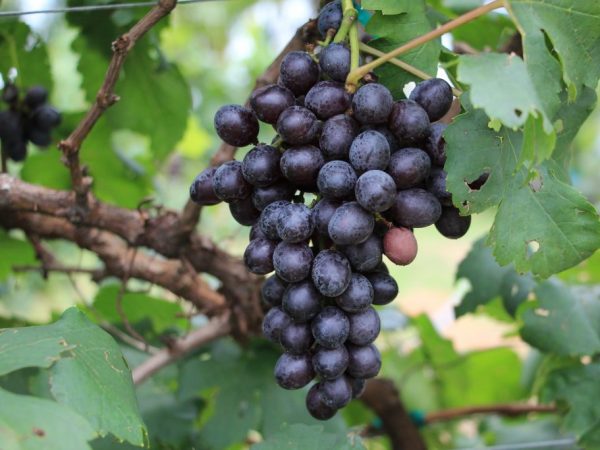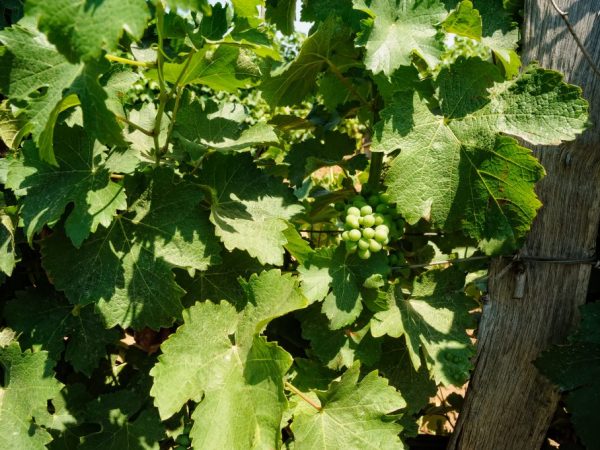Characteristics of the grape variety Valiant
Valiant grapes contain a huge amount of nutrients.

Characteristics of the variety
The Valiant grape variety is obtained by crossing frost-resistant varieties. He was qualified as a universal hybrid.
Valiant is suitable for the production of high quality blended wines and juices.
The variety is winter-hardy. Due to its good frost resistance and the characteristics of the vine, it is grown throughout Russia, including the northern regions.
Full ripening occurs early, at the end of August. For the northern regions, the harvest date is shifted to the first ten days of September. Vegetation lasts 128-138 days.
Designers use Valiant to decorate garden plots and summer gazebos, fences or verandas. Beautiful green foliage gives the site a fresh look.
Saplings are unpretentious to climatic conditions.
Description of the bush
Description of the Valiant grape vine:
- vigorous, lush bushes;
- pubescence of shoots is small;
- green color;
- open petiole notch;
- high winter hardiness;
- early maturation;
- high productivity.
3-5 clusters are formed on each shoot.
Fruit characteristics
Delicious, healthy and beautiful Valiant has high sugar content (up to 20%) and medium acidity (10-11%).
Description of bunches and berries:
- the shape of the bunch is conical;
- berries fit snugly together;
- the leg is treelike;
- the weight of one berry is from 1.8 g to 3 g;
- bunch weight - up to 100 g;
- the shape of the berries is correct, oval;
- the color of the fruit is black with a purple tint.
A characteristic whitish bloom appears on the berries, which is well washed off with running water. The berries are fragrant, with a strawberry flavor. The pulp is hidden under the easily removable skin, sweet and juicy.
Growing grapes

Proper care will ensure you have a good harvest
The quality of the Valiant grapes depends on the conditions of care and planting. It can withstand frosts down to -45 ° С, does not require shelter. In the suburbs, in the Leningrad region, it takes root easily and quickly. The climatic conditions of these areas are ideal for a hybrid.
Landing
For planting in the garden, choose a place that is not blown through by drafts, with good lighting.
Planting is carried out in the spring or autumn. The day before the procedure, the roots are soaked in water so that they are leveled and saturated with moisture.
A hole of 70 x 80 cm is dug to a depth of 60 cm, black soil or a nutrient mixture prepared from the excavated soil and organic fertilizers is poured onto the bottom and in the center. A support rod is placed in the center. Next to it, spreading the roots, they put a seedling and add earth to it.
After that, the soil is compacted in the root zone and poured abundantly with water at room temperature (4 buckets for each bush).
The distance between the bushes is kept within 0.5 m. After the first watering, the soil is mulched with any suitable material. This protects it from drying out and germination of weeds.
Watering
Watering is carried out after visual inspection, as the earth dries up.If the season is rainy, they make sure that the soil does not become waterlogged: this entails rotting of the root system. To prevent this from happening, drainage holes and depressions are made near the root zone.
Under normal climatic conditions, 4 buckets of water are added monthly for each plant. After complete absorption of moisture into the soil, mulching and weeding are carried out, which interfere with the normal development of the vine.
The best option is drip irrigation. It provides even moisture penetration and solves the problem of liquid fertilization without the risk of burns on the leaves.
Pruning
Correct pruning is essential for high yields. It is held twice a season:
- In the spring, at the beginning of the growing season. At this point, all dry branches are removed.
- At the end of summer. Shoots are shortened by 30 cm, dried leaves are cut off.
Pruning allows the berries to ripen better and get more nutrients.
Top dressing
Fertilization is carried out three times a season. This activity helps to increase the yield, improve its quality and increase the protective properties of the bushes.
In the spring, during the beginning of the growing season, mineral fertilizers are applied. In summer, potassium and phosphorus are added, which contribute to the ripening of fruits.
In late autumn, during the pre-winter preparation period, at the same time as watering the land, organic matter, humus and mullein diluted in water are introduced.
Disease prevention
Valiant's average resistance to diseases obliges to carry out preventive measures to prevent them.
This versatile hybrid is susceptible to mildew and powdery mildew. The drugs Kaptan, Dichlorfluanid, Folpet, Mankotseb, Maneb, Metiram, Propineb, Tiram, Tsineb are used against the fungus. In advanced cases, the use of a fungicide, copper or sulfur is effective.
The rainy season provokes powdery mildew. To resist the disease, to prevent its occurrence, it is necessary to treat with fungicides on the leaf or shelter the shrubs from moisture.
If you suspect a disease on a windless day, the bushes are pollinated with sulfur. If this is not possible, use the store-bought drugs "Karatan", "Baylon", "Topsin-M" or "Rubigan".
Conclusion
The Valiant grape variety has become widespread due to its excellent technical characteristics and taste. Disease resistance is compensated by high frost resistance. Excellent taste, lack of peas and good transportability make this species attractive for mass sales.

